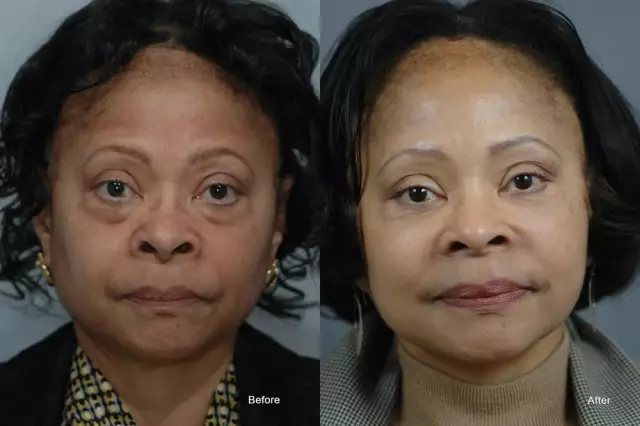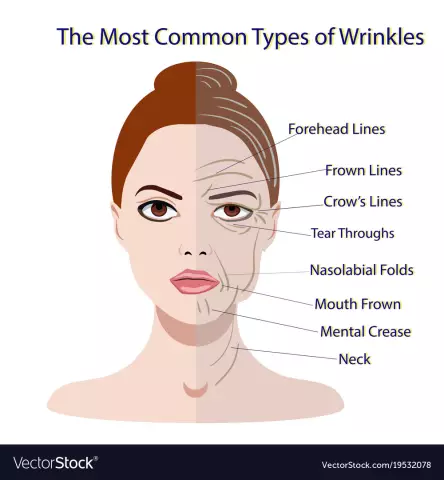- Author Rachel Wainwright [email protected].
- Public 2023-12-15 07:39.
- Last modified 2025-11-02 20:14.
Facial contouring

Over time, the skin loses its firmness and elasticity, which leads to the appearance of wrinkles. Some wrinkles can be prevented and eliminated with laser devices, botulinum therapy or contouring. Facial contouring is a method of removing deep and fine wrinkles using injections of gels of various compositions.
Numerous reviews of face contouring indicate the demand and popularity of this procedure. Contouring is most often used to model the cheekbones, to eliminate the nasolabial fold, to correct the shape of the nose, to change the shape of the face, the shape of the chin, to fill in static wrinkles, as well as to raise the eyebrows, correct atrophic scars, and correct the shape of the lips. The effectiveness of contour plasty largely depends on the characteristics of the body and facial expressions of the patient.
Facial contouring with fillers
Fillers for facial contouring are injected with a cannula or a thin needle into those areas of the skin where collagen is destroyed or lost. Fillers (fillers) are temporary, long-acting and permanent (permanent).
Temporary fillers are considered the safest. Many of them are produced on the basis of bovine and pork collagen (Ziplast, Ziederm, Collost and others). Long-acting fillers are represented by combined preparations based on components of industrial and natural origin.
These fillers contain microparticles that prolong the contouring effect and stimulate the growth of new collagen. These include Dermalife, Arteplast, Matrigel, Evolution, Profil. The effect of the introduction of these drugs lasts for more than two years.
Permanent fillers are rarely used in face contouring. Permanent fillers (synthetic gels) are used to reduce or increase the volume of adipose tissue in the subcutaneous tissue. Permanent fillers include Cosmogel, Silicon-1000, Amazingel, Aquamid and others.
Description of the facial contouring procedure with fillers
Many reviews of facial contouring say that this procedure usually lasts from thirty to forty minutes. It is performed using special anesthetic ointments or under local anesthesia. The patient's sensations are largely determined by the area of filler injection during contouring. On the day of the procedure, the patient should smile as little as possible so that the drug is evenly distributed under the skin.
Hyaluronic acid facial contouring

Hyaluronic acid facial contouring is the most popular and safe procedure. This component of non-animal origin is identical in structure to hyaluronic acid contained in the skin and other tissues and organs of a person. Hydrophilicity is the main feature of this acid. Hyaluronic acid is capable of attracting many water molecules.
Hyaluronic acid facial contouring improves turgor, elasticity and viscoelastic properties of the skin. And if the volume created during the contouring with hyaluronic acid does not suit the patient, then an enzyme that breaks down this substance is injected under the skin.
Hyaluronic acid-based drugs include Restylane, Belotero, Sujiderm, Teosial, Yuvederm and others. Contour correction with hyaluronic acid allows you to eliminate signs of photoaging of the skin, raise the corners of the eyes and mouth, correct the cheekbones and chin contours, and the line of the lower jaw. Acid-based drugs have virtually no side effects.
Contraindications and possible complications after face contouring
Contour plastics should not be used for allergies to pain relievers or filler components, for autoimmune diseases (scleroderma, Hashimoto's disease, rheumatic diseases of the joints), for bactericidal, viral, fungal skin diseases.
You should not use face contouring during pregnancy and lactation, with immune and infectious diseases, with type 1 and 2 diabetes mellitus, with a tendency to hypertrophic and keloid scars, as well as after recent chemical peeling procedures, mechanical or laser resurfacing, with the use of drugs that suppress immunity.
Found a mistake in the text? Select it and press Ctrl + Enter.






